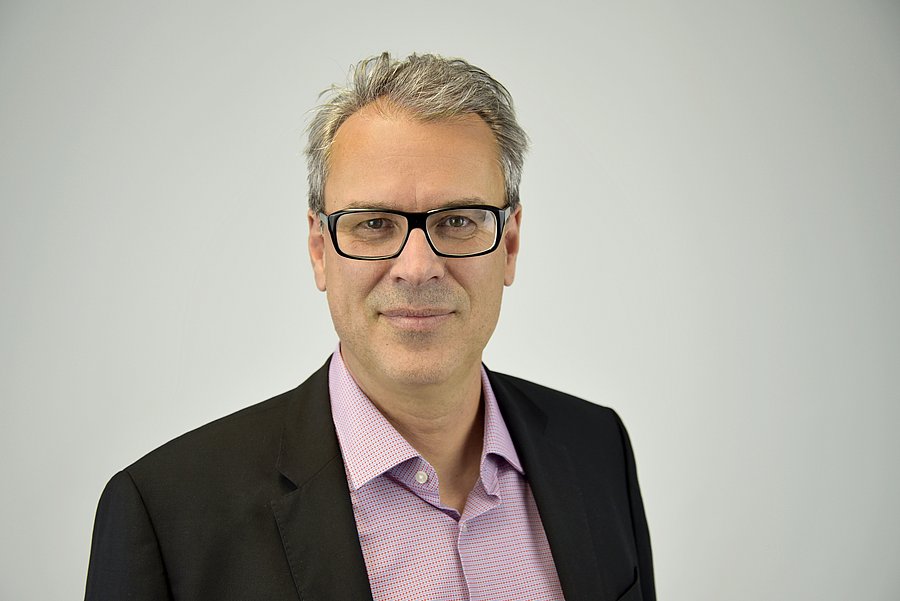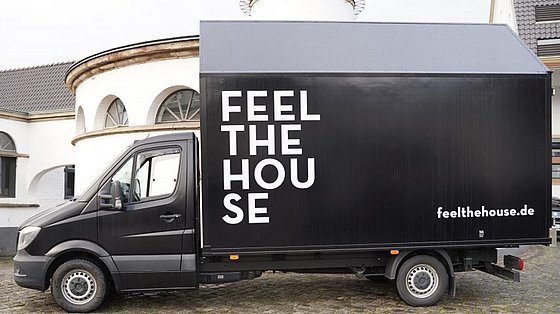
Photo exhibition FEEL-THE-HOUSE
Prof. Georg Giebeler / Architecture
Photo: Friederike von Heyden
Incredibly many houses are insanely beautiful
Prof. Georg Giebeler on the mobile, photographic architecture exhibition FEEL-THE-HOUSE with impressive buildings that trigger emotions
How do you describe a house that you like? As a rule, you describe it with adjectives that trigger a feeling that simply comes from the gut, explains Georg Giebeler, architect and head of the Department of Building with Existing Structures and Building Construction at Bergische Universität. Accordingly, a house can be perceived as elegant, kitschy, luxurious, brutal or bleak, depending on the emotion of the observer.
On October 11, Wuppertaler*innen can view this unique exhibition dedicated to anonymous architecture in a specially converted mobile at the university's Haspel site before it goes on a major tour of Germany. "The very normal, fine architecture that some dedicated architect - there were only a few female architects back then - thought, planned and built beautifully in the 1970s has disappeared from view," says Giebeler, "There is a lot of this good architecture that just stands there and no one cares about anymore. A lot of these buildings are actually not protected, and it's about preserving that heritage as well."
The House Archive Emerges
Giebeler founded the so-called Haus-Archiv back in the 1990s, when he was still a research assistant in the architecture faculty at RWTH Aachen University. "That's when I first started collecting houses with students; specifically, houses of everyday architecture that are not famous," he says, explaining his idea. That's why there are no buildings by famous architects among the entire photos, as well as theaters, opera houses, city halls or special buildings, which include our Historische Stadthalle. "Houses are collected that surround us normally, that you normally walk past. But if you look more closely, you can see special features on them, typological features. You recognize something about these houses." Since then, Giebeler has repeatedly carried out these photo searches with students, which train their eye for the 'normal special'. Initially very open and free, Giebeler continued to develop these photo seminars, which he eventually also conducted with students from Wuppertal after working at RheinMain University. "As a rule, it's always about three different objects of a house that are very similar in terms of typology," he says, describing the task of the seminar, which only takes place in the winter semester, because then no foliage disturbs the view of the objects, and gives an example: "For example, you have a mountain bungalow that stands on a slope. It has only one floor on the street side, with a front door in it, a small toilet window, a garage in the wall, and a kitchen window facing the front. To the back you know, there it is then two stories with a large glazing. Everybody knows that. A typical 60s property. A student, for example, photographed this and found three very similar houses, but they are not in the same city at all, they are spread out in the region. And when you see the three photos side by side, you realize that these houses were designed and built in a similar way everywhere. That's the point." Giebeler thus trains the eye of future architects* who, through this seminar, perceive a city in a completely different way. "You recognize Art Nouveau by the way it's ornamented, but you also recognize a '50s building by the way it has balcony railings, or a '60s building by the windows, which often have such horizontal ribbon facades. Students learn outside of an architectural theory that informs them about the famous architec*ts, that you can see that in the everyday." The House Archive collects all these finds, of which there are now more than 500 images.
"A lot more people need to see this..."
A unique traveling exhibition has now been created under the title FEEL-THE-HOUSE, which will be on display once more at the Haspel site on October 11 before its tour. "I always said a lot more people need to see this, and I really wanted to do an exhibit," Giebeler explains. "This name FEEL-THE-HOUSE, just like the whole exhibition, is an idea of Rebecca Schröder, who is a research assistant here at the chair but essentially the owner of the res d agency in Cologne." Their Design and architecture GmbH concerns itself primarily with exhibition organization, which visitors country widely could already become acquainted with among other things in the Neandertalmuseum, the Bochumer mining museum as well as the Humboldtbox in Berlin. Schröder, who was familiar with Giebeler's collection, put together an event concept that could be understood academically, architecturally, and by citizens outside the field. Adjectives then came into play in the didactic implementation. "When you talk about houses, you don't say, 'Oh, that's a beautiful building from the 1950s,' that's not how the normal person talks, but you associate it with adjectives that trigger a feeling. FEEL-THE-HOUSE is the feeling that viewing this house triggers, and it triggers it abruptly, from the gut," Giebeler explains. The planning team specifically searched for words that express this gut feeling, sorted the images and stamped them on the back in uni-green with terms such as bleak, brutal, kitschy, and so on. The exhibition now uses stamp rondels familiar from any office. Visitors can use these seals, marked with the respective adjectives, and 'restamp' an already stamped photo if they think an object triggers a different emotion. "This is well received," Giebeler knows, as the exhibit has already been on display for two days in June. "It's not only interaction, but people come out of the exhibit and say, I've restamped a lot, and it sparks a discussion."

Photo: FEEL-THE-HOUSE-Mobile by Georg Giebeler
The FEEL-THE-HOUSE Mobile
But what makes this traveling exhibition so special is its mobile location, because FEEL-THE-HOUSE is housed in a 3.5-ton truck, and for good reason. "The problem with traveling exhibitions when you design them and target them at architecture faculties, because that's our target group, is you never get a commitment," knows Giebeler, who has also served as a dean and knows the structures of university administrations. That's because space and time must then be created and staff must be made available to protect the exhibits, he says, so requests are often set aside. "And then I've thought, you have to drive there with a thing, open the door and then the exhibit is there. Nobody minds because there's no work involved, and that proves true." But the FEEL-THE-HOUSE mobile is particularly eye-catching because it has been converted into a house. "We bought a regular panel van, tore off the flat roof and put a pitched roof, a peaked roof on it," Giebeler says. "Then we had it sprayed black, because that's part of the look of the show. Inside, it's built out in bright uni-green, has a huge mirror in front of the head, and in the middle, something like an old counter that you know from the former record stores. And that's where the pictures are sorted, like rock and pop, punk and jazz, and structured from elegant to bleak."
Wuppertal architecture chair tours Germany
"We are now traveling to ten other universities, architecture faculties, crisscrossing Germany in mid-October at the start of the semester," says Giebeler enthusiastically. In the fall, for example, the mobile will make guest appearances in Kaiserslautern, Weimar, Dresden, Berlin and Bremen, among others, and will continue the tour in the spring via Munich, Graz and Innsbruck. "At the end, we will then be here in Wuppertal once again."
FEEL-THE-HOUSE is the somewhat different architectural exhibition of a very ambitious team of professors at Bergische Universität.
Uwe Blass (conversation from 08/19/2021)
Prof. Georg Giebeler has been head of the Chair of Building with Existing Structures and Building Construction at Bergische Universität since 2018.
